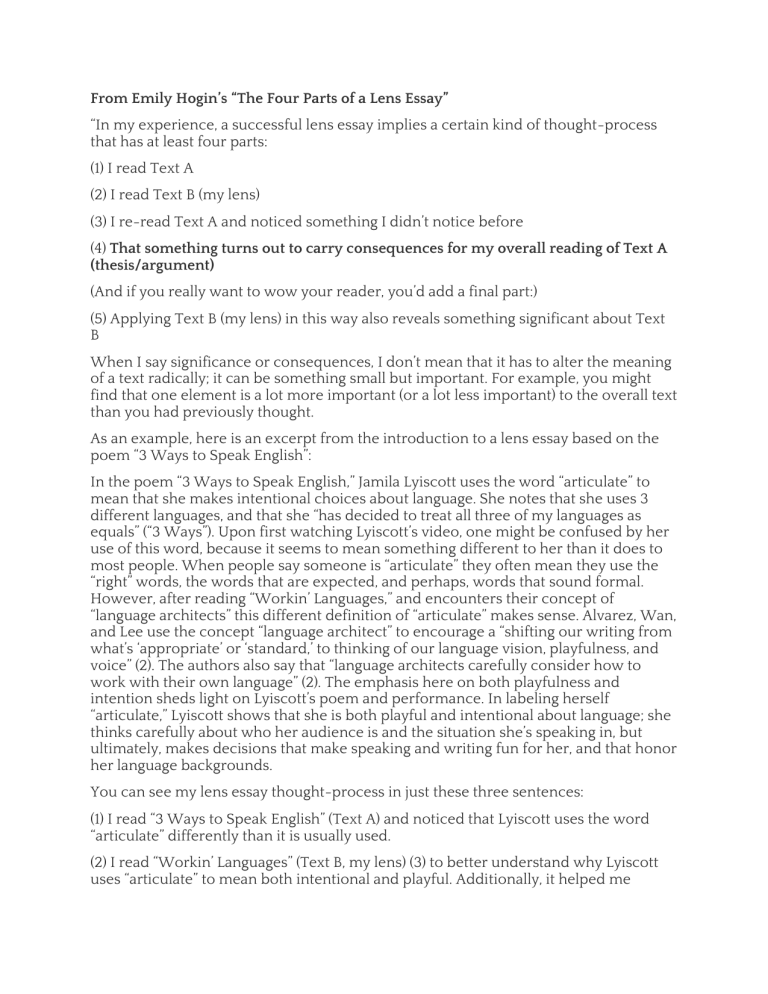
From Emily Hogin’s “The Four Parts of a Lens Essay” “In my experience, a successful lens essay implies a certain kind of thought-process that has at least four parts: (1) I read Text A (2) I read Text B (my lens) (3) I re-read Text A and noticed something I didn’t notice before (4) That something turns out to carry consequences for my overall reading of Text A (thesis/argument) (And if you really want to wow your reader, you’d add a final part:) (5) Applying Text B (my lens) in this way also reveals something significant about Text B When I say significance or consequences, I don’t mean that it has to alter the meaning of a text radically; it can be something small but important. For example, you might find that one element is a lot more important (or a lot less important) to the overall text than you had previously thought. As an example, here is an excerpt from the introduction to a lens essay based on the poem “3 Ways to Speak English”: In the poem “3 Ways to Speak English,” Jamila Lyiscott uses the word “articulate” to mean that she makes intentional choices about language. She notes that she uses 3 different languages, and that she “has decided to treat all three of my languages as equals” (“3 Ways”). Upon first watching Lyiscott’s video, one might be confused by her use of this word, because it seems to mean something different to her than it does to most people. When people say someone is “articulate” they often mean they use the “right” words, the words that are expected, and perhaps, words that sound formal. However, after reading “Workin’ Languages,” and encounters their concept of “language architects” this different definition of “articulate” makes sense. Alvarez, Wan, and Lee use the concept “language architect” to encourage a “shifting our writing from what’s ‘appropriate’ or ‘standard,’ to thinking of our language vision, playfulness, and voice” (2). The authors also say that “language architects carefully consider how to work with their own language” (2). The emphasis here on both playfulness and intention sheds light on Lyiscott’s poem and performance. In labeling herself “articulate,” Lyiscott shows that she is both playful and intentional about language; she thinks carefully about who her audience is and the situation she’s speaking in, but ultimately, makes decisions that make speaking and writing fun for her, and that honor her language backgrounds. You can see my lens essay thought-process in just these three sentences: (1) I read “3 Ways to Speak English” (Text A) and noticed that Lyiscott uses the word “articulate” differently than it is usually used. (2) I read “Workin’ Languages” (Text B, my lens) (3) to better understand why Lyiscott uses “articulate” to mean both intentional and playful. Additionally, it helped me understand why that change in meaning is important–because it subverts the idea that writing and speaking should be subject to the standards of appropriateness. but (4) applying “Workin’ Languages” to the poem tells me that Alvarez, Wan, and Lee’s theory is also enriched by a filmed example. Lyiscott’s “unique vision” (2) and the way she “works” her language (2) can be seen not only in the word choices she makes, but also in the physical choices she makes while speaking–her postures, gestures, etc. and the way she changes her voice–using things such as pitch and rhythm to indicate what language(s) she’s using at the moment.





